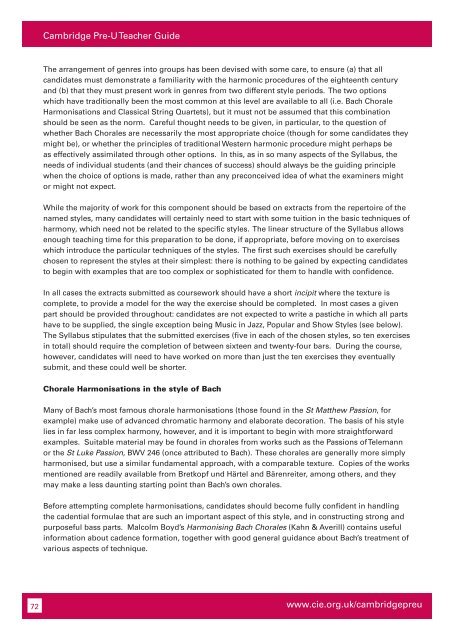Teacher's Guide Cambridge Pre-U MUSIC Available for teaching ...
Teacher's Guide Cambridge Pre-U MUSIC Available for teaching ...
Teacher's Guide Cambridge Pre-U MUSIC Available for teaching ...
Create successful ePaper yourself
Turn your PDF publications into a flip-book with our unique Google optimized e-Paper software.
72<br />
<strong>Cambridge</strong> <strong>Pre</strong>-U Teacher <strong>Guide</strong><br />
The arrangement of genres into groups has been devised with some care, to ensure (a) that all<br />
candidates must demonstrate a familiarity with the harmonic procedures of the eighteenth century<br />
and (b) that they must present work in genres from two different style periods. The two options<br />
which have traditionally been the most common at this level are available to all (i.e. Bach Chorale<br />
Harmonisations and Classical String Quartets), but it must not be assumed that this combination<br />
should be seen as the norm. Careful thought needs to be given, in particular, to the question of<br />
whether Bach Chorales are necessarily the most appropriate choice (though <strong>for</strong> some candidates they<br />
might be), or whether the principles of traditional Western harmonic procedure might perhaps be<br />
as effectively assimilated through other options. In this, as in so many aspects of the Syllabus, the<br />
needs of individual students (and their chances of success) should always be the guiding principle<br />
when the choice of options is made, rather than any preconceived idea of what the examiners might<br />
or might not expect.<br />
While the majority of work <strong>for</strong> this component should be based on extracts from the repertoire of the<br />
named styles, many candidates will certainly need to start with some tuition in the basic techniques of<br />
harmony, which need not be related to the specific styles. The linear structure of the Syllabus allows<br />
enough <strong>teaching</strong> time <strong>for</strong> this preparation to be done, if appropriate, be<strong>for</strong>e moving on to exercises<br />
which introduce the particular techniques of the styles. The first such exercises should be carefully<br />
chosen to represent the styles at their simplest: there is nothing to be gained by expecting candidates<br />
to begin with examples that are too complex or sophisticated <strong>for</strong> them to handle with confidence.<br />
In all cases the extracts submitted as coursework should have a short incipit where the texture is<br />
complete, to provide a model <strong>for</strong> the way the exercise should be completed. In most cases a given<br />
part should be provided throughout: candidates are not expected to write a pastiche in which all parts<br />
have to be supplied, the single exception being Music in Jazz, Popular and Show Styles (see below).<br />
The Syllabus stipulates that the submitted exercises (five in each of the chosen styles, so ten exercises<br />
in total) should require the completion of between sixteen and twenty-four bars. During the course,<br />
however, candidates will need to have worked on more than just the ten exercises they eventually<br />
submit, and these could well be shorter.<br />
Chorale Harmonisations in the style of Bach<br />
Many of Bach’s most famous chorale harmonisations (those found in the St Matthew Passion, <strong>for</strong><br />
example) make use of advanced chromatic harmony and elaborate decoration. The basis of his style<br />
lies in far less complex harmony, however, and it is important to begin with more straight<strong>for</strong>ward<br />
examples. Suitable material may be found in chorales from works such as the Passions of Telemann<br />
or the St Luke Passion, BWV 246 (once attributed to Bach). These chorales are generally more simply<br />
harmonised, but use a similar fundamental approach, with a comparable texture. Copies of the works<br />
mentioned are readily available from Bretkopf und Härtel and Bärenreiter, among others, and they<br />
may make a less daunting starting point than Bach’s own chorales.<br />
Be<strong>for</strong>e attempting complete harmonisations, candidates should become fully confident in handling<br />
the cadential <strong>for</strong>mulae that are such an important aspect of this style, and in constructing strong and<br />
purposeful bass parts. Malcolm Boyd’s Harmonising Bach Chorales (Kahn & Averill) contains useful<br />
in<strong>for</strong>mation about cadence <strong>for</strong>mation, together with good general guidance about Bach’s treatment of<br />
various aspects of technique.<br />
www.cie.org.uk/cambridgepreu
















